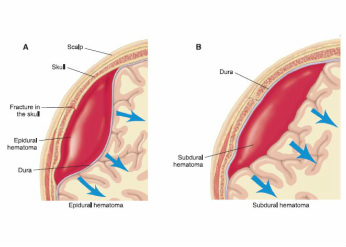|
|
Pathology definition - Epidural Hematoma

Epidural hematoma
Epidural hematoma is associated with alteration of consciousness, lucid interval, seizures, altered in the mental status, headache, focal neurological deficit and coma. Epidural hematoma commonly due to blood accumulation between the skull and the dura.
Commonly surgical drainage is required. The common complication of epidural hematoma is cerebral compression. Epidural hematoma is precipitated by injury to the head which finally lead to fracture of the skull. Epidural hematoma may occur as a result of a tear of the middle meningeal vessels( middle meningeal artery, middle meningeal vein) and dural sinus.
Common landmark of epidural hematoma is the present of biconcave disk which does not cross the lines of suture which is detected on the CT scan.
References
1.Roda, JoséM., Daniel Giménez, Antonio Pérez-Higueras, Martin G. Blázquez, and Marcelino Pérez-Alvarez. “Posterior Fossa Epidural Hematomas: A Review and Synthesis.” Surgical Neurology 19, no. 5 (May 1983): 419–424. doi:10.1016/0090-3019(83)90138-6.
2.Arkins TJ, McLennan JE, Winston KR, Strand RD, and Suzuki Y. “ACute Posterior Fossa Epidural Hematomas in Children.” American Journal of Diseases of Children 131, no. 6 (June 1, 1977): 690–692. doi:10.1001/archpedi.1977.02120190084019.
Epidural hematoma is associated with alteration of consciousness, lucid interval, seizures, altered in the mental status, headache, focal neurological deficit and coma. Epidural hematoma commonly due to blood accumulation between the skull and the dura.
Commonly surgical drainage is required. The common complication of epidural hematoma is cerebral compression. Epidural hematoma is precipitated by injury to the head which finally lead to fracture of the skull. Epidural hematoma may occur as a result of a tear of the middle meningeal vessels( middle meningeal artery, middle meningeal vein) and dural sinus.
Common landmark of epidural hematoma is the present of biconcave disk which does not cross the lines of suture which is detected on the CT scan.
References
1.Roda, JoséM., Daniel Giménez, Antonio Pérez-Higueras, Martin G. Blázquez, and Marcelino Pérez-Alvarez. “Posterior Fossa Epidural Hematomas: A Review and Synthesis.” Surgical Neurology 19, no. 5 (May 1983): 419–424. doi:10.1016/0090-3019(83)90138-6.
2.Arkins TJ, McLennan JE, Winston KR, Strand RD, and Suzuki Y. “ACute Posterior Fossa Epidural Hematomas in Children.” American Journal of Diseases of Children 131, no. 6 (June 1, 1977): 690–692. doi:10.1001/archpedi.1977.02120190084019.
